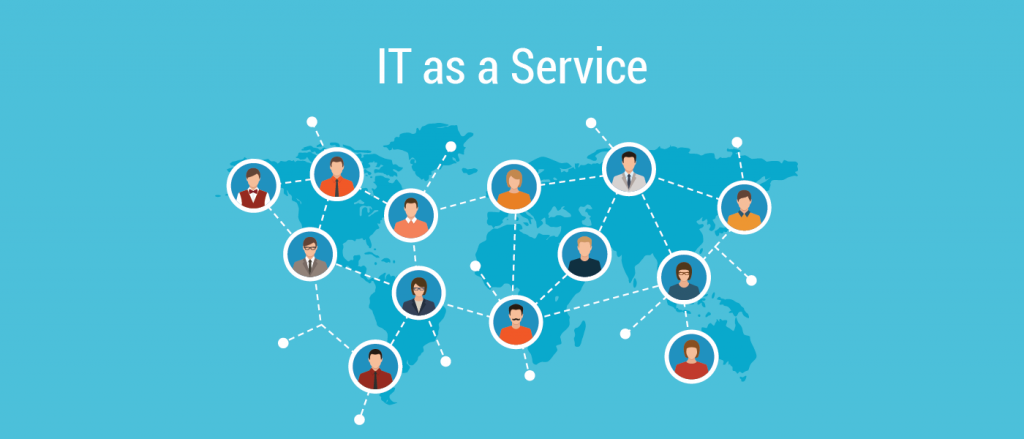How IT-as-a-Service Boost the Digital Transformation of Enterprises
IT-as-a-Service (ITaaS) is now a key driver of digital transformation in enterprises. ITaaS treats information technology as a commodity and provides the enterprise with scalable and flexible hardware, software, and support. Enterprises may subscribe to the quantum of resources they require, with easy scalability up and down to suit the changing business requirements.
Such a model offers tremendous benefits for the enterprise.
Scalability and Flexibility to Suit Today’s Business needs
The subscription-based model offered by ITaaS, with a monthly fee paid by the business depending on the number of users and systems in-use of the business, perfectly syncs with today’s business requirements.
For businesses in the growth pace, and for startups, the ready scalability on offer ensures steady growth of IT capabilities to match business growth, without sapping the enterprise energy and resources on provisioning for the same.
Even entrenched enterprises with a dedicated IT department, complete with on-premises servers find the scalability offered by ITaaS handy to augment resources when needed. The ITaaS provider, could, for instance, service end-users and application faults, leaving the in-house IT team to support the core infrastructure components.
The unbridled scalability also comes with flexibility. ITaaS is platform agnostic and offers a flexible delivery model. At the same time, it retains an element of standardization and predictability. The net result is enterprise consumers getting the best of both worlds, resilient to operate in any condition, and the highest levels of service.
ITaaS is delivered from the existing on-premise server rooms, through colocation from a hosted data center environment, or through a cloud-based model. It is possible to mix and match these delivery modes as well.
Implementing ITaaS, however, requires an overhaul of the existing IT ecosystem. While this comes with the usual pangs of change, it also presents an opportunity to overhaul the setup and make it more efficient. Several wasteful practices, and ad-hoc processes, accumulated over the years, may easily be done away with, in favor of the highly efficient ITaaS. Enterprises nevertheless do face some challenges in integrating cloud solutions with legacy systems., and making sure the applications are ‘cloud-friendly’ in terms of latency, and file structure.
As high as 91% of CIOs welcome the flexibility offered by ITaaS, confirming the fact the benefits of ITaaS are for real.
Expert Support Just a Call Away
The unprecedented scalability on offer is also backed up by 24×7 support, and access to expert technical resources. IN today’s age of talent crunch, such resources may not be easy to come by in-house, and even I available, may not make financial sense.
Most ITaaS operators also provide self-service support portals, allowing users to open support tickets, check the FAQs, follow guides and read knowledge base articles, all without involving the IT department. This greatly enhances functional efficiency and accelerates troubleshooting times. This perfectly syncs with the emerging and hugely popular work from home concepts.
Minimal Upfront IT Investment
In today’s age of heightened competition, many CFO’s prefer to keep purse-strings close to their chest, and are reluctant to invest in anything more than what is absolutely necessary. They usually strike down IT investments which do not generate direct returns on investments, regardless of the scope of indirect benefits. IT as a Service, by allowing the enterprise to invest only for the exact amount of resources required, is music to the ears of such CFOs.
With ITaaS, the enterprise is spared from investing in unneeded infrastructure for future contingencies or be straddled with excess resources no longer required in the foreseeable future. Enterprises are also spared from the costly capital expenditure. With ITaaS, excess capacity, often considered part of the cost of doing business, is totally being eliminated. ITaaS expenditure is transparent, and easily attributable to the operational domain for which it is used. The costs for each transaction can be clearly attributed, and assigned to the end users. Shifting the costs from capital expenditure to operational expenditure also brings significant tax advantages to the table.
ITaaS also contributes to financial stability for the enterprise. With ItaaS, IT expenditure becomes a regular and predictable exercise, rather than one-off capital shocks.
Easy Availability of New Technology
The world of technology is in a state of flux, with new technologies emerging by the day. ITaaS offers enterprise the opportunity to experiment with the latest technology and implement what works for them. Enterprises are spared from spending a fortune up front on an uncertain technology.
More importantly, ITaaS guarantees up to date hardware, and also regular software patches and upgrades. Enterprises are free from the hassles of having to upgrade their IT infrastructure and can focus their attention on their core business process, or serve their customers.
Maintaining up to date systems is important both from a reliability and functional standpoint.
IT-as-a-Service improves network security in a big way.
Enterprises ignore network security at their own peril. The latest Verizon data breach report reveals 70% of all cyber attacks exploiting known vulnerabilities, and some vulnerabilities date back to 1999! ITaaS delivers a coordinated patch regime, ensuring systems are less vulnerable to attacks. ITaaS providers deploy service agents on the IT infrastructure estate of the company, to highlight known vulnerabilities and out-of-date software. The ecosystem also gets the benefits of regular system backups, pre-deployment testing, and patch updates.
ITaaS also enables continuous monitoring of service, Unified monitoring solutions track utilization, key metrics related to network health, and undertake trend analysis. These solutions cross-correlate code-level and transaction-level performance with the health of the supporting infrastructures, to flag issues as soon as it emerges. Such proactive monitoring identifies the symptoms and indications of a fault before it escalates into a major issue.
The 2017 Global Technology, Media and Telecommunications Predictions Report by Deloitte estimates global spending on IT-as-a-Service to touch $550 billion by the end of 2018. Enterprises currently spent about 25% of their IT budgets on pay-per-use services, on average. Deloitte Global expects the figure to jump to about 35% this year, and to 50% by 2022.
ITaaS is clearly the future, with enterprises no longer having to overpay for things they don’t need. However, the extent to which it serves enterprise needs depends on the extent to which CIOs can align ITaaS with business needs.
Stay up to date on what's new

Recommended Posts

22 Aug 2020
What Is IT Consulting? How Can It Revitalize Your Business?
Why Does Your Business Need IT Consulting Services? IT departments or on-site IT professionals have become increasingly significant for many types of organizations- small and large, today. As the COVID-19……

23 Oct 2017 Manufacturing
How Simplified IT Operations Increased ROI of the World’s Largest Cooler Manufacturer
A business can significantly benefit from top-of-the-line IT infrastructure that helps reduce costs and thereby increase revenue. Organizations today find it necessary to have an entire space dedicated to top……

02 Jun 2016
The Real Reason Why You Need to Seek Advice From IT Professionals
According to data collected from almost 788 small firms by Fasthosts Internet, it is found that there is a huge difference in terms of adopting new technology in the workplace……
Featured Blogs
Stay up to date on
what's new






















































